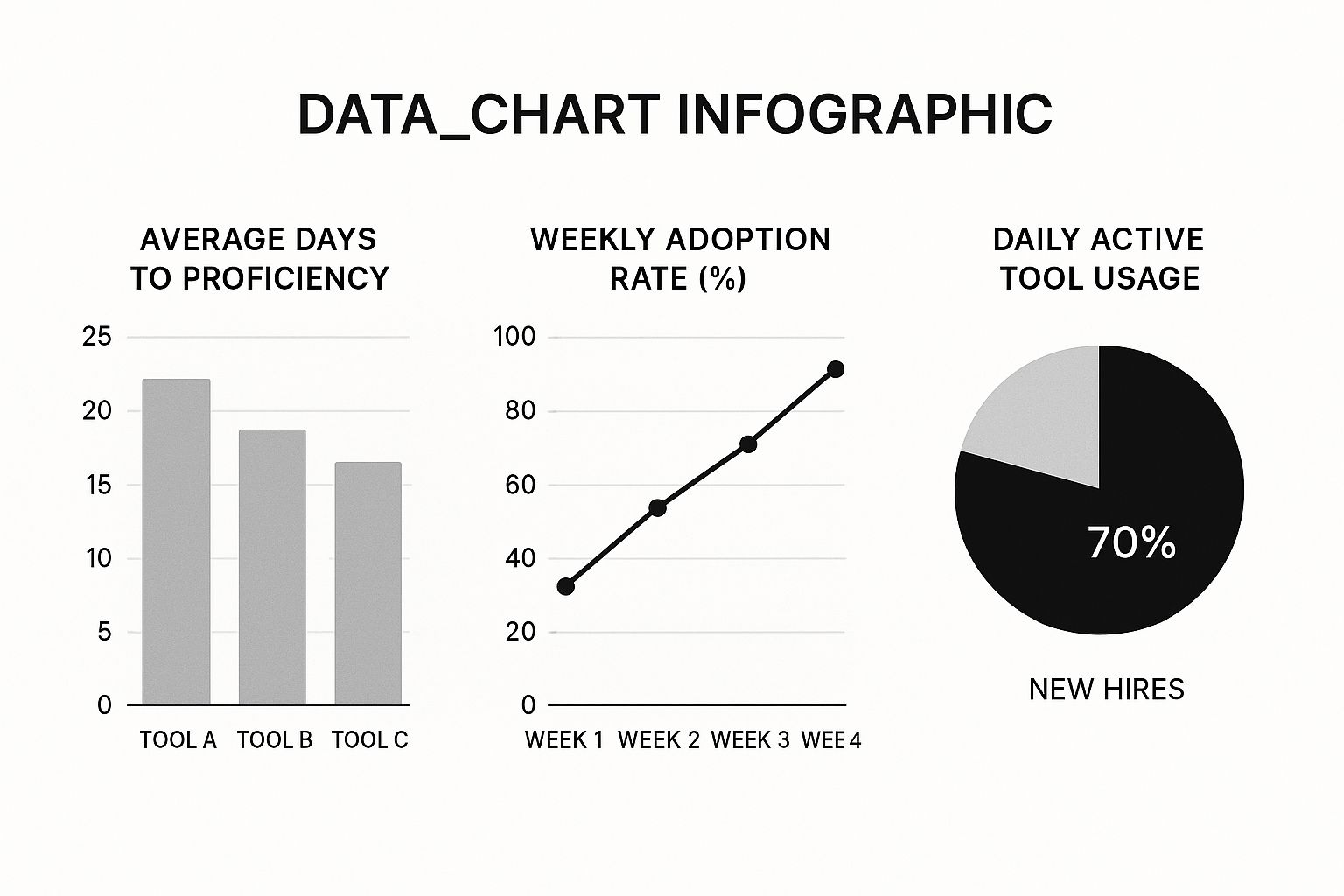Shrinking Your Time to Productivity
When you bring a new person onto your team, there’s always a crucial gap between their first day and the moment they start delivering real, tangible value to your organisation. This is what we call time to productivity (TTP). Think of it as the ramp-up time a new hire needs before they’re a fully contributing member of the team. A shorter TTP means you see a return on your recruitment investment much faster and your whole operation becomes more agile.
Defining Time to Productivity And Its Importance

Let’s say you’ve just hired a brilliant new software developer. Their salary and other costs kick in from day one, but their true value isn’t felt until they can write code independently, collaborate effectively on projects, and solve problems without needing constant hand-holding. This period, from their start date until they reach full effectiveness, is their time to productivity.
This metric is much more than just a number on an HR dashboard. It’s a vital sign that tells you a lot about the health and efficiency of your entire talent acquisition and management process. If your TTP is consistently long, it’s often a symptom of deeper issues that need fixing.
Why This Metric Is A Business Imperative
A slow ramp-up doesn’t just affect the new hire. Its impact ripples across the entire organisation, putting a strain on budgets, team morale, and project deadlines. That’s why understanding and shrinking your TTP isn’t just a “nice-to-have”—it’s a strategic necessity for any company that wants to grow and stay competitive.
Here’s why focusing on TTP is so critical:
- Return on Investment (ROI): Every single day a new hire isn’t fully productive, you’re paying a salary without getting the full value of that role in return. Shortening this period directly speeds up your return on recruitment costs.
- Team Capacity and Morale: When a new person is getting up to speed, who picks up the slack? Your existing team. A faster integration process reduces this extra burden on your experienced staff, preventing burnout and frustration.
- Operational Agility: In today’s fast-moving markets, being able to onboard talent quickly and get them contributing means you can execute projects faster. This agility is what allows you to respond to market shifts and customer demands more effectively.
- Employee Retention: A smooth, efficient onboarding process that helps new employees feel competent and successful from the get-go is directly linked to higher job satisfaction. Employees who feel lost or ineffective in their first few months are far more likely to start looking elsewhere.
A new hire is like a high-performance engine; you wouldn’t expect it to hit top speed the moment it’s installed. The quality of the installation and warm-up—your onboarding process—determines how quickly and efficiently it performs.
Ultimately, a well-managed time to productivity is a reflection of your company’s internal systems, from how accurately you write your job descriptions to the quality of your training programmes. It’s a direct measure of how effectively your organisation can absorb new talent and convert it into real results.
How to Measure Time to Productivity Accurately
Measuring time to productivity can feel like trying to nail jelly to a wall. It’s a vital metric, but how do you make it tangible? The secret is to move past guesswork and build a clear, consistent framework. A fair measurement system avoids a one-size-fits-all approach, recognising that full productivity looks completely different from one role to the next.
The whole process starts by defining what “fully productive” actually means for each position. A software developer’s key milestones, for instance, will naturally centre on their ability to independently contribute to the codebase. On the other hand, a salesperson’s productivity is tied directly to hitting their first sales targets. Pinning down these outcomes is the first, most crucial step towards an accurate measurement.
Combining Hard Data with Human Insight
A solid time to productivity calculation needs a balanced perspective. It’s about blending the objective numbers with subjective, but equally important, human observations. If you only rely on one type of data, you’re only getting half the story.
- Quantitative Data (The What): This is all about the measurable output. We’re talking hard numbers like the volume of support tickets a new agent resolves, the number of qualified leads a marketer generates, or the percentage of a sales quota achieved. These metrics give you clear, objective proof of performance.
- Qualitative Data (The How): This is where you find the context behind the numbers. It includes a manager’s feedback on a new hire’s problem-solving skills, how well they collaborate with the team, and their overall level of independence. It answers the critical question: “Are they just ticking off tasks, or are they truly integrating into the team’s workflow?”
A truly effective measurement system tracks genuine progress, not just activity. It differentiates between someone who is busy and someone who is creating real value for the business.
This balanced view ensures you’re tracking real contribution, not just keeping people busy.
A Practical Framework for Measurement
To build a system you can rely on, start by creating a simple checklist for each role that maps out the journey to full productivity. You can break down a new hire’s first 90 days into distinct phases, each with its own specific goals.
Below, the infographic highlights key metrics for tracking a new hire’s growing proficiency, including their tool adoption rates and daily usage.

The data clearly shows a direct link between a structured onboarding process and faster adoption of essential tools, which in turn has a massive impact on a new hire’s time to productivity.
To help structure this, here’s a breakdown of how you might track progress across different departments.
Key Metrics for Measuring Time to Productivity
| Department | Quantitative Metric (Example) | Qualitative Metric (Example) | Productivity Milestone |
|---|---|---|---|
| Sales | 75% of monthly sales quota met | Consistently leads client discovery calls without support | Independently closes first major deal |
| Software Development | 10 story points completed in a sprint | Receives positive peer review on code quality | Submits first feature to production with minimal rework |
| Customer Support | Average handling time below 5 minutes | Achieves a 90% positive customer satisfaction (CSAT) score | Resolves complex tier-2 tickets without escalation |
| Marketing | Generates 50 Marketing Qualified Leads (MQLs) | Proposes a new, successful A/B test for a campaign | Manages a small marketing campaign from start to finish |
This table illustrates how specific, role-based metrics can create a much clearer picture of a new hire’s journey.
The final piece of the puzzle is setting a clear endpoint for the measurement period. This “graduation point” could be when the employee consistently meets 80-90% of the performance standards of a tenured colleague, or when they no longer need intensive supervision for their core tasks. By defining this milestone, you create a clear finish line, turning an abstract concept into a tangible and powerful business metric.
Understanding Your Time to Productivity Benchmarks

Once you’ve got a handle on measuring time to productivity, the next question is obvious: what’s a ‘good’ number? There’s no one-size-fits-all answer. It changes dramatically from one industry to another and really hinges on how complex the role is. To set the right expectations, you need to look at what’s happening in your field.
Of course, a shorter ramp-up period is always better, but “short” can mean very different things. Think about it: a new hire in a Business Process Outsourcing (BPO) role, armed with structured scripts and focused training, might be hitting their stride in just a few weeks. On the flip side, an R&D engineer in manufacturing could easily need over six months to really get their head around complex product cycles and start contributing to innovation in a meaningful way.
Benchmarks Across Key Indian Industries
Setting realistic goals means you need to understand the typical ramp-up times for your specific sector. Every industry has its own unique set of challenges that directly impact how quickly a new employee can start delivering real value.
- IT and Tech Services: For entry-level coders or support staff, a time to productivity of 2-3 months is a common benchmark. But for senior developers or specialists working with niche tech, this can easily stretch to 4-6 months.
- BPO and Customer Service: This sector often boasts the shortest TTP, usually somewhere between 3 to 6 weeks. This speed is thanks to highly structured training programmes and standardised workflows.
- Manufacturing and Engineering: Roles here often involve complicated machinery and strict safety protocols. This pushes the average TTP to 5-8 months, especially for positions that demand deep domain knowledge.
A benchmark isn’t just a number to beat; it’s a strategic tool. It helps you identify whether your onboarding process is a competitive advantage that accelerates growth or a hidden bottleneck holding you back from market leadership.
Factors Influencing Indian Benchmarks
To really make sense of these numbers, you have to look at the bigger picture. In India, a few unique factors are shaping these benchmarks, from regional talent pools to specific skill gaps that are hard to ignore.
These challenges pop up in broader economic trends, too. For instance, India’s labour productivity growth recently slowed to 2.38%. This is partly due to those very skills gaps and a lack of investment in new technology. This slowdown makes getting people up to speed efficiently more critical than ever for business success.
What’s more, as you can dig into with various India skills reports, the availability of job-ready talent can be wildly different from one city or state to the next. This directly affects how long it takes to get new hires fully trained. By comparing your organisation’s TTP against these industry and regional standards, you arm yourself with the insights needed to set ambitious, yet totally achievable, goals for improvement.
The Hidden Costs of a Slow Ramp-Up Period
When a new hire takes a long time to get up to speed, it feels like more than just a delay. It’s a quiet tax that slowly bleeds your company’s resources. The most obvious cost is the salary you’re paying out for weeks—or even months—before that person starts delivering any real value. But that’s just the tip of the iceberg. The true financial damage runs much deeper, sending ripples across the entire business.
These expenses pile up quickly and go far beyond just the payroll. Think about the sunk costs from recruitment agency fees, not to mention the ongoing expense of training programmes, materials, and the trainers’ time. Plus, every hour a manager or senior colleague spends hand-holding a new hire is an hour they aren’t spending on their own critical work, which creates a serious drag on team productivity.
The Financial Drain of Inefficiency
Calculating the direct cost can be a real eye-opener. A simple formula can help you see the damage in black and white: take the new hire’s total monthly cost (salary plus overheads) and multiply it by the number of months it takes them to become fully productive. For someone costing your company ₹1,00,000 a month who needs six months to ramp up, you’ve sunk a huge investment before you see a full return.
But even this calculation doesn’t tell the whole story. The real pain often comes from the opportunities you miss along the way.
- Lost Revenue: Every week a new salesperson isn’t closing deals, or a new developer isn’t shipping code, is potential revenue just vanishing into thin air.
- Delayed Projects: A slow start for one person can put critical projects on hold, pushing back deadlines and hurting your competitive edge.
- Strained Team Capacity: Who picks up the slack? Your existing team. They have to carry the extra weight, which can quickly lead to burnout, low morale, and a dip in their own performance.
The Connection Between Onboarding and Turnover
The consequences aren’t just financial. A frustrating, drawn-out onboarding is one of the biggest reasons new employees leave within their first year. When people feel useless and unsupported in their first few months, their excitement evaporates, they disengage, and they start wondering if they made the right choice in joining your company.
This kind of disengagement is a huge problem. For example, workforce engagement in India recently plummeted to just 19%, the most severe drop recorded anywhere in the world. This low engagement, often stemming from a poor start at a new job, is directly linked to lower productivity and can trigger a mass exit of skilled people. You can dig deeper into the serious business costs of low engagement by reading the full report on workforce engagement trends.
A slow time to productivity does more than just hurt your bottom line; it damages your company culture. High early-turnover sends a clear message to your existing team that the organisation struggles to set its people up for success.
Ultimately, if you don’t shorten the ramp-up period, you’re not just losing money—you’re actively building a disengaged workforce. That’s why improving your time to productivity is a critical move for both your financial health and your ability to keep great talent for the long haul.
Actionable Strategies to Shorten Time to Productivity
Getting a new hire from their first day to full-throttle contribution doesn’t just happen on its own. It’s not a case of hoping they’ll “figure it out.” If you want to shorten the time to productivity and see a quicker return on your hiring investment, you need a deliberate, structured playbook. The whole game is about creating an environment built on clarity, support, and empowerment.
A great place to start is with a well-thought-out 30-60-90 day plan. This is much more than a simple to-do list; think of it as a roadmap. It should outline specific, progressive goals for their first three months on the job. When you set clear expectations for learning, performance, and cultural integration at each stage, you wipe out any confusion and give your new hire a real sense of progress right from their first week.
Foster Connection and Independent Learning
Nobody finds their feet in a vacuum. New employees need a solid support system to help them navigate the ins and outs of a new role and company culture. One of the best ways to provide this is through a buddy system. Pairing a new hire with a seasoned team member (who isn’t their manager) gives them a safe, informal sounding board for all those little questions they might feel hesitant to ask their boss.
This simple step does wonders for building social connections and helps them absorb the company culture much faster. They get to grips with the unwritten rules and informal networks that are critical for getting work done efficiently.
At the same time, you need to empower them to learn independently. Give them easy access to on-demand resources through a central, searchable knowledge base. This hub can contain everything from process documents and training videos to past project details. It not only saves managers a ton of time but also builds a sense of autonomy and problem-solving in the new hire from day one.
- Structured 30-60-90 Day Plans: Set clear, achievable milestones for the first three months.
- Buddy Systems: Pair new hires with experienced peers for informal guidance and support.
- On-Demand Resources: Create a self-service knowledge hub to promote independent problem-solving.
Redefine Productivity Beyond Hours Worked
There’s a common and dangerous myth in the workplace: more hours automatically mean more output. This idea is a direct path to employee burnout and, ironically, lower productivity. The real way to achieve sustainable productivity and a shorter ramp-up time is to focus on the quality of work, employee well-being, and smarter processes.
Improving time to productivity requires a focus on quality, upskilling, and well-being, not just longer hours. Pushing for a longer workweek is a counterproductive strategy that ultimately harms both employees and the bottom line.
The evidence consistently shows that working excessive hours actually hurts productivity. For example, despite recent pushes in some circles for longer workweeks, India’s hourly productivity is around $8.70. Compare that to the UK, where it’s approximately $54.30 with fewer average working hours. This huge gap is often tied to burnout, which a recent survey found affected a staggering 58% of Indian workers. You can read more about the impact of long hours on India’s productivity on LSE’s Business Review.
By shifting the focus to effective training, clear goal-setting, and a healthy work-life balance, organisations can help new hires become productive much faster and in a way that lasts. For those looking to build a team that truly thrives, exploring different career paths and opportunities at Taggd can offer more insights into creating a successful, productive work environment.
How to Accelerate Your Team’s Productivity

Even with the best strategies in place, specific questions and hurdles always pop up when you’re trying to shrink your team’s time to productivity. Answering these common challenges head-on can help you fine-tune your approach and avoid preventable setbacks. This ensures your new hires integrate smoothly and start adding real value much faster.
This section tackles the most frequent questions leaders ask. We’ll explore the direct link between onboarding structure and ramp-up speed, the role technology plays, and the single biggest mistake that can derail all your progress. Think of this as your quick-reference guide to clearing the final hurdles in optimising your team’s performance.
How Structured Onboarding Impacts Productivity
A structured onboarding programme is, without a doubt, the most powerful lever you can pull to shorten time to productivity. An informal, “sink or swim” approach just doesn’t work. It leaves new hires feeling confused, disengaged, and taking far longer to find their footing, which costs the company both time and money.
On the other hand, a well-organised process provides a clear roadmap. It sets expectations from day one, introduces new team members to key people and resources systematically, and builds their confidence with early wins. A structured approach removes the guesswork, allowing them to focus on learning their role instead of trying to navigate internal bureaucracy. The impact is significant, often cutting ramp-up time by 50% or more.
“Hoping you will find the time is not a good strategy. You won’t find the time. Time does not like a vacuum. There will always be something to do, and if you have not planned what you will do, your time will be filled with low-value trivial tasks.”
This couldn’t be more true for new hires. Without a plan, their time will be filled with confusion, not meaningful contribution.
The Role of Technology in Accelerating Ramp-Up
Technology is a critical accelerator in this process. Modern tools can automate those repetitive administrative tasks, deliver consistent training modules on-demand, and create collaborative spaces where new hires can instantly connect with mentors and colleagues. An integrated HR tech stack makes the entire onboarding journey more efficient and data-driven.
For instance, a good Learning Management System (LMS) can deliver personalised training paths, while project management tools like Asana or Trello offer clear visibility into workflows. Communication platforms like Slack or Microsoft Teams facilitate instant connections and knowledge sharing. By using technology to support the onboarding journey, you create a seamless experience that empowers new hires to learn faster and more independently, which directly shrinks their time to productivity.
The table below contrasts how different onboarding approaches affect this crucial metric, showing a clear difference between an ad-hoc process and a well-planned one.
Onboarding Strategy Impact on Time to Productivity
| Onboarding Aspect | Traditional Approach (High TTP) | Structured Approach (Low TTP) |
|---|---|---|
| First Week | Ad-hoc meetings, paperwork, general confusion. | Pre-planned schedule, welcome kit, clear 30-day goals. |
| Training | Shadowing without context, inconsistent information. | Formal training modules, dedicated mentors, and a buddy system. |
| Resources | Information is scattered across people and drives. | Centralised knowledge base, accessible process documents. |
| Feedback | Infrequent, informal, and often delayed. | Regular, scheduled check-ins with clear performance feedback. |
This comparison really highlights how a structured, tech-enabled process removes friction and accelerates a new hire’s progress from day one.
The Single Biggest Mistake Companies Make
The most common and damaging mistake we see is failing to define what ‘productivity’ actually looks like for each role. Without a clear definition and specific milestones, the entire concept of TTP becomes a vague, unmeasurable goal. Managers are left guessing what “good” looks like, and new hires have no clear target to aim for.
This lack of clarity leads to inconsistent evaluations and a frustrating experience for everyone involved. A new salesperson doesn’t know what a successful first month looks like, and a developer has no idea when they are expected to be contributing code independently. Before you can shorten the time to productivity, you must first define it with concrete, role-specific metrics. This foundational step is essential, as everything else is built upon it. It’s a key part of learning how to hire top talent and accelerate your recruitment process.
